headlamp CHEVROLET CAMARO 1967 1.G Chassis Workshop Manual
[x] Cancel search | Manufacturer: CHEVROLET, Model Year: 1967, Model line: CAMARO, Model: CHEVROLET CAMARO 1967 1.GPages: 659, PDF Size: 114.24 MB
Page 136 of 659
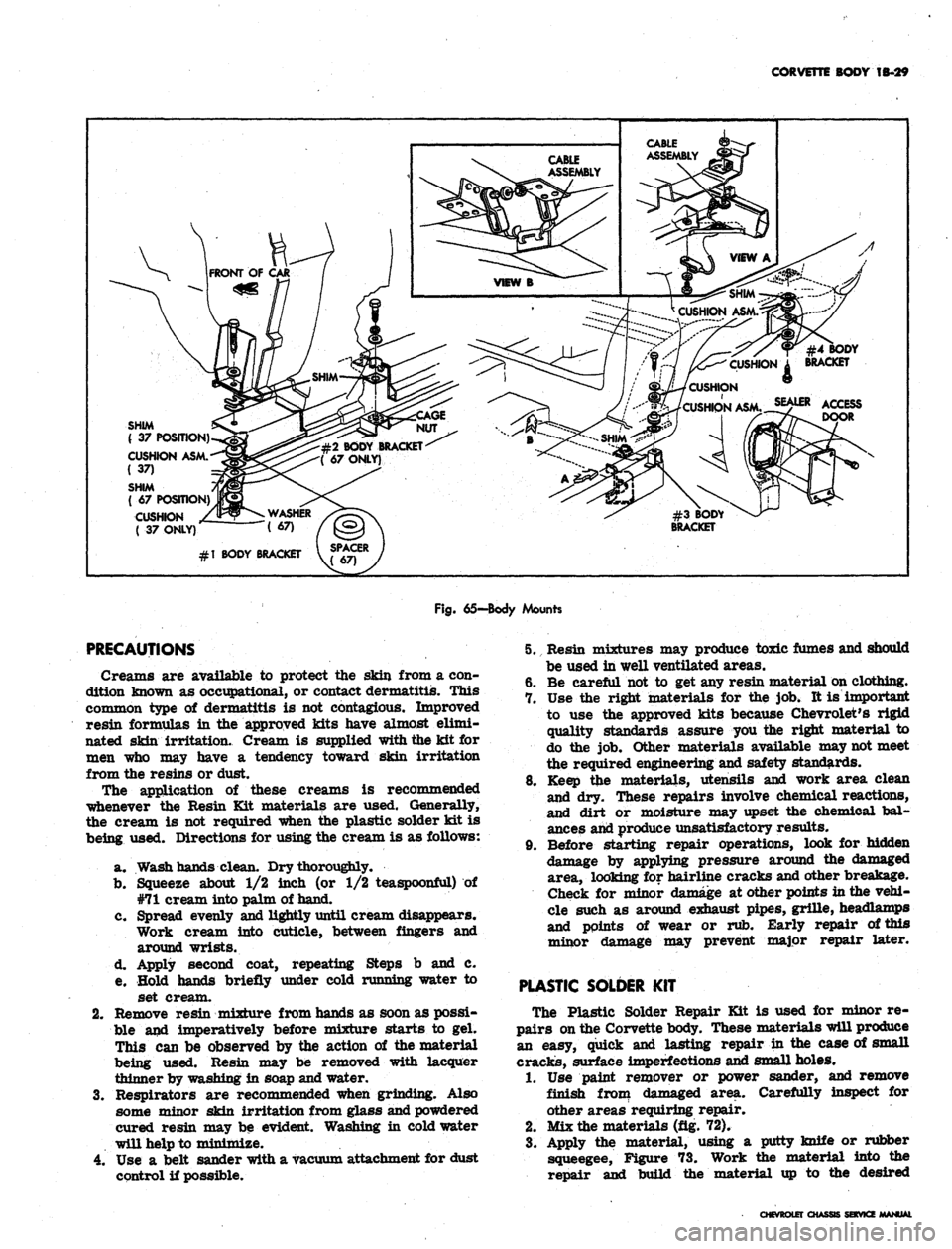
CORVETTE BODY 1B-29
CUSHION
CUSHION ASNi.^ty** ACCESS
#2 BODY BRACKET
( 67 ONLY)
SHIM
( 37 POSITION).
CUSHION ASM.
( 37)
SHIM
( 67 POSITION)
CUSHION
( 37 ONLY)
#1 BODY BRACKET
Fig.
65—Body Mounts
PRECAUTIONS
Creams are available to protect the skin from a con-
dition known as occupational, or contact dermatitis. This
common type of dermatitis is not contagious. Improved
resin formulas in the approved kits have almost elimi-
nated skin irritation. Cream is supplied with the kit for
men who may have a tendency toward skin irritation
from the resins or dust.
The application of these creams is recommended
whenever the Resin Kit materials are used. Generally,
the cream is not required when the plastic solder kit is
being used. Directions for using the cream is as follows:
a. Wash hands clean. Dry thoroughly.
b.
Squeeze about 1/2 inch (or 1/2 teaspoonful) of
#71 cream into palm of hand.
c. Spread evenly and lightly until cream disappears.
Work cream into cuticle, between fingers and
around wrists.
d. Apply second coat, repeating Steps b and c.
e. Hold hands briefly under cold running water to
set cream.
2.
Remove resin mixture from hands as soon as possi-
ble and imperatively before mixture starts to gel.
This can be observed by the action of the material
being used. Resin may be removed with lacquer
thinner by washing in soap and water.
3.
Respirators are recommended when grinding. Also
some minor skin irritation from glass and powdered
cured resin may be evident. Washing in cold water
will help to minimize.
4.
Use a belt sander with a vacuum attachment for dust
control if possible.
5. Resin mixtures may produce toxic fumes and should
be used in well ventilated areas.
6. Be careful not to get any resin material on clothing.
7. Use the right materials for the job. It is important
to use the approved kits because Chevrolet's rigid
quality standards assure you the right material to
do the job. Other materials available may not meet
the required engineering and safety standards.
8. Keep the materials, utensils and work area clean
and dry. These repairs involve chemical reactions,
and dirt or moisture may upset the chemical bal-
ances and produce unsatisfactory results.
9. Before starting repair operations, look for hidden
damage by applying pressure around the damaged
area, looking for hairline cracks and other breakage.
Check for minor damage at other points in the vehi-
cle such as around exhaust pipes, grille, headlamps
and points of wear or rub. Early repair of this
minor damage may prevent major repair later.
PLASTIC SOLDER
KIT
The Plastic Solder Repair Kit is used for minor re-
pairs on the Corvette body. These materials will produce
an easy, quick and lasting repair in the case of small
cracks, surface imperfections and small holes.
1.
Use paint remover or power sander, and remove
finish from damaged area. Carefully inspect for
other areas requiring repair.
2.
Mix the materials (fig. 72).
3.
Apply the material, using a putty knife or rubber
squeegee, Figure 73. Work the material into the
repair and build the material up to the desired
CHEVROLET CHASSIS SERVICE
Page 491 of 659
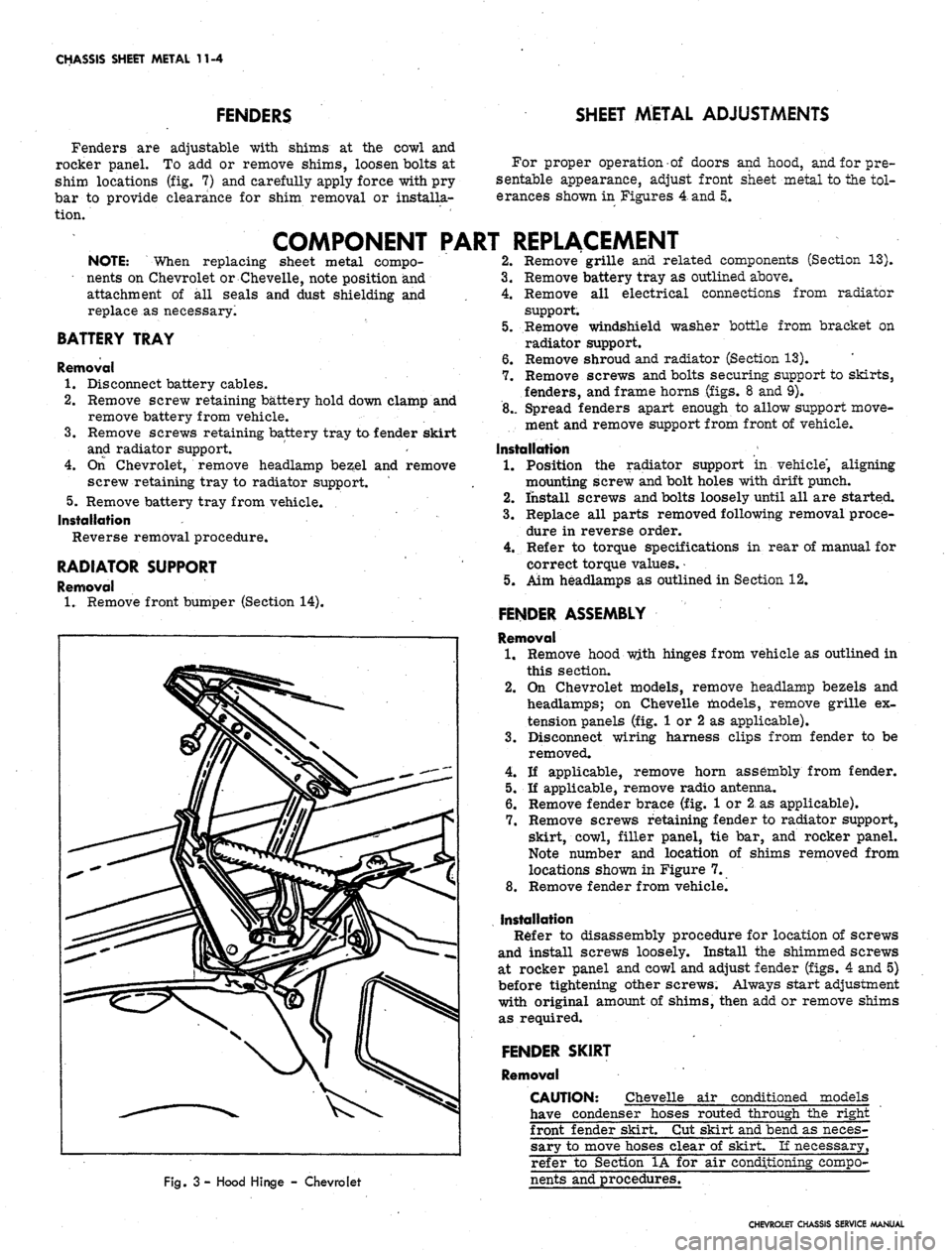
CHASSIS SHEET METAL 11-4
FENDERS
Fenders are adjustable with shims at the cowl and
rocker panel. To add or remove shims, loosen bolts at
shim locations (fig. 7) and carefully apply force with pry
bar to provide clearance for shim removal or installa-
tion.
SHEET METAL ADJUSTMENTS
For proper operation of doors and hood, and for pre-
sentable appearance, adjust front sheet metal to the tol-
erances shown in Figures
4-
and 5.
COMPONENT PART REPLACEMENT
NOTE: When replacing sheet metal compo-
nents on Chevrolet or Chevelle, note position and
attachment of all seals and dust shielding and
replace as necessary.
BATTERY TRAY
Removal
1.
Disconnect battery cables.
2.
Remove screw retaining battery hold down clamp and
remove battery from vehicle.
3.
Remove screws retaining battery tray to fender skirt
and radiator support.
4.
On Chevrolet, remove headlamp bezel and remove
screw retaining tray to radiator support.
5.
Remove battery tray from vehicle.
Installation
Reverse removal procedure.
RADIATOR SUPPORT
Removal
1.
Remove front bumper (Section 14).
Fig.
3 - Hood Hinge - Chevrolet
2.
Remove grille and related components (Section 13).
3.
Remove battery tray as outlined above.
4.
Remove all electrical connections from radiator
support.
5.
Remove windshield washer bottle from bracket on
radiator support.
6. Remove shroud and radiator (Section 13).
7.
Remove screws and bolts securing support to skirts,
fenders, and frame horns (figs. 8 and 9).
8.. Spread fenders apart enough to allow support move-
ment and remove support from front of vehicle.
Installation
1.
Position the radiator support in vehicle", aligning
mounting screw and bolt holes with drift punch.
2.
install screws and bolts loosely until all are started.
3.
Replace all parts removed following removal proce-
dure in reverse order.
4.
Refer to torque specifications in rear of manual for
correct torque values.
•
5.
Aim headlamps as outlined in Section 12.
FENDER ASSEMBLY
Removal
1.
Remove hood with hinges from vehicle as outlined in
this section.
2.
On Chevrolet models, remove headlamp bezels and
headlamps; on Chevelle models, remove grille ex-
tension panels (fig. 1 or 2 as applicable).
3.
Disconnect wiring harness clips from fender to be
removed.
4.
If applicable, remove horn assembly from fender.
5.
If applicable, remove radio antenna.
6. Remove fender brace (fig. 1 or 2 as applicable).
7.
Remove screws retaining fender to radiator support,
skirt, cowl, filler panel, tie bar, and rocker panel.
Note number and location of shims removed from
locations shown in Figure 7.
8. Remove fender from vehicle.
Installation
Refer to disassembly procedure for location of screws
and install screws loosely. Install the shimmed screws
at rocker panel and cowl and adjust fender (figs. 4 and 5)
before tightening other screws. Always start adjustment
with original amount of shims, then add or remove shims
as required.
FENDER SKIRT
Removal
CAUTION: Chevelle air conditioned models
have condenser hoses routed through the right
front fender skirt. Cut skirt and bend as neces-
sary to move hoses clear of skirt. If necessary,
refer to Section 1A for air conditioning compo-
nents and procedures.
CHEVROLET CHASSIS SERVICE MANUAL
Page 498 of 659
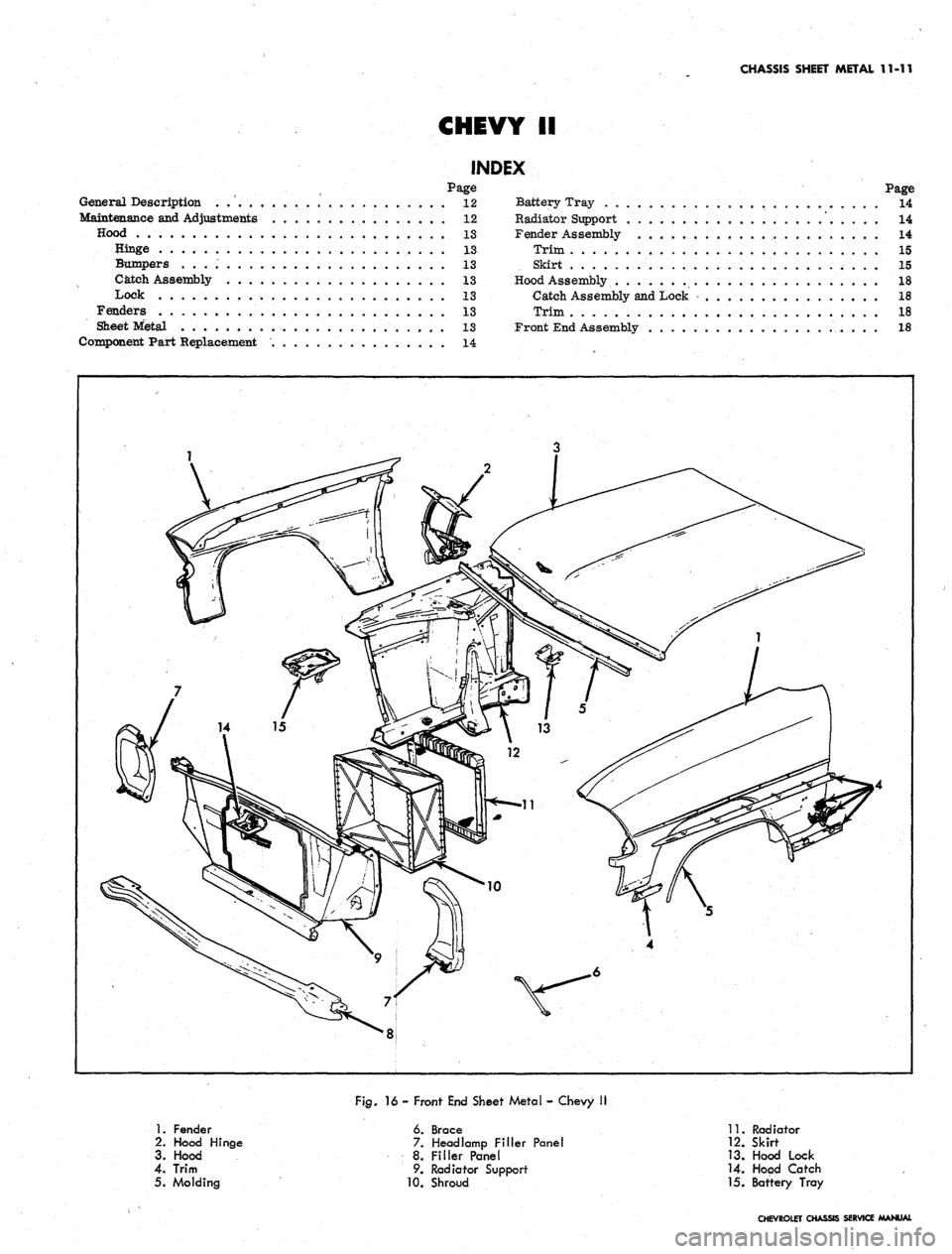
CHASSIS SHEET METAL 11-11
CHEVY II
INDEX
Page
General Description 12
Maintenance and Adjustments 12
Hood ........ 13
Hinge 13
Bumpers 13
Catch Assembly . . . 13
Lock 13
Fenders . 13
Sheet Metal 13
Component Part Replacement 14
Page
Battery Tray 14
Radiator Support 14
Fender Assembly ...................... 14
Trim 15
Skirt 15
Hood Assembly 18
Catch Assembly and Lock • 18
Trim 18
Front End Assembly 18
1.
Fender
2.
Hood Hinge
3. Hood
4.
Trim
5. Molding
Fig.
16 - Front End Sheet Metal - Chevy II
6. Brace
7. Headlamp Filler Panel
8. Filler Panel
9. Radiator Support
10.
Shroud
11.
Radiator
12.
Skirt
13.
Hood Lock
14.
Hood Catch
15.
Baftery Tray
CHEVROLET CHASSIS SERVICE MANUAL
Page 501 of 659
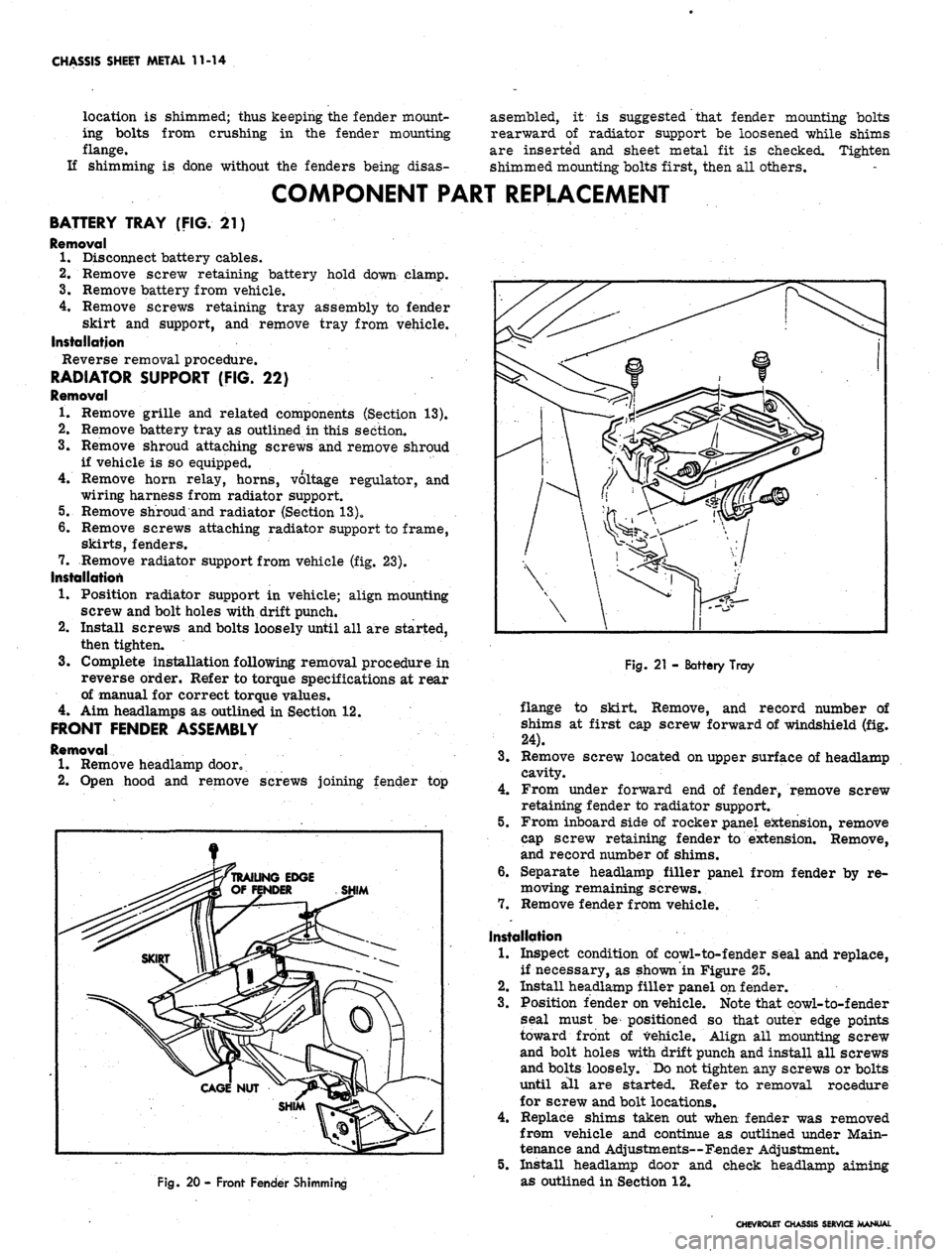
CHASSIS SHEET METAL 11-14
location is shimmed; thus keeping the fender mount-
ing bolts from crushing in the fender mounting
flange.
If shimming is done without the fenders being disas-
asembled, it is suggested that fender mounting bolts
rearward of radiator support be loosened while shims
are inserted and sheet metal fit is checked. Tighten
shimmed mounting bolts first, then all others.
COMPONENT PART REPLACEMENT
BATTERY TRAY (FIG. 21)
Removal
1.
Disconnect battery cables.
2.
Remove screw retaining battery hold down clamp.
3.
Remove battery from vehicle.
4.
Remove screws retaining tray assembly to fender
skirt and support, and remove tray from vehicle.
Installation
Reverse removal procedure.
RADIATOR SUPPORT (FIG. 22)
Removal
1.
Remove grille and related components (Section 13).
Remove battery tray as outlined in this section.
Remove shroud attaching screws and remove shroud
if vehicle is so equipped.
Remove horn relay, horns, voltage regulator, and
wiring harness from radiator support.
Remove shroud and radiator (Section 13)o
Remove screws attaching radiator support to frame,
skirts,
fenders.
Remove radiator support from vehicle (fig. 23).
Installation
1.
Position radiator support in vehicle; align mounting
screw and bolt holes with drift punch.
Install screws and bolts loosely until all are started,
then tighten.
3.
Complete installation following removal procedure in
reverse order. Refer to torque specifications at rear
of manual for correct torque values.
4.
Aim headlamps as outlined in Section 12.
FRONT FENDER ASSEMBLY
Removal
1*
Remove headlamp dooro
2.
Open hood and remove screws joining fender top
2.
Fig. 20 - Front Fender Shimming
Fig.
21 - Battery Tray
flange to skirt. Remove, and record number of
shims at first cap screw forward of windshield (fig.
24).
3.
Remove screw located on upper surface of headlamp
cavity.
4.
From under forward end of fender, remove screw
retaining fender to radiator support.
5.
From inboard side of rocker panel extension, remove
cap screw retaining fender to extension. Remove,
and record number of shims.
6. Separate headlamp filler panel from fender by re-
moving remaining screws.
7.
Remove fender from vehicle.
Installation
1.
Inspect condition of cowl-to-fender seal and replace,
if necessary, as shown in Figure 25.
2.
Install headlamp filler panel on fender.
3.
Position fender on vehicle. Note that eowl-to-fender
seal must be positioned so that outer edge points
toward front of vehicle. Align all mounting screw
and bolt holes with drift punch and install all screws
and bolts loosely. Do not tighten any screws or bolts
until all are started. Refer to removal rocedure
for screw and bolt locations.
4.
Replace shims taken out when fender was removed
from vehicle and continue as outlined under Main-
tenance and Adjustments—Fender Adjustment.
5.
Install headlamp door and cheek headlamp aiming
as outlined in Section 12.
CHEVROLET CHASSIS SERVICE MANUAL
Page 505 of 659
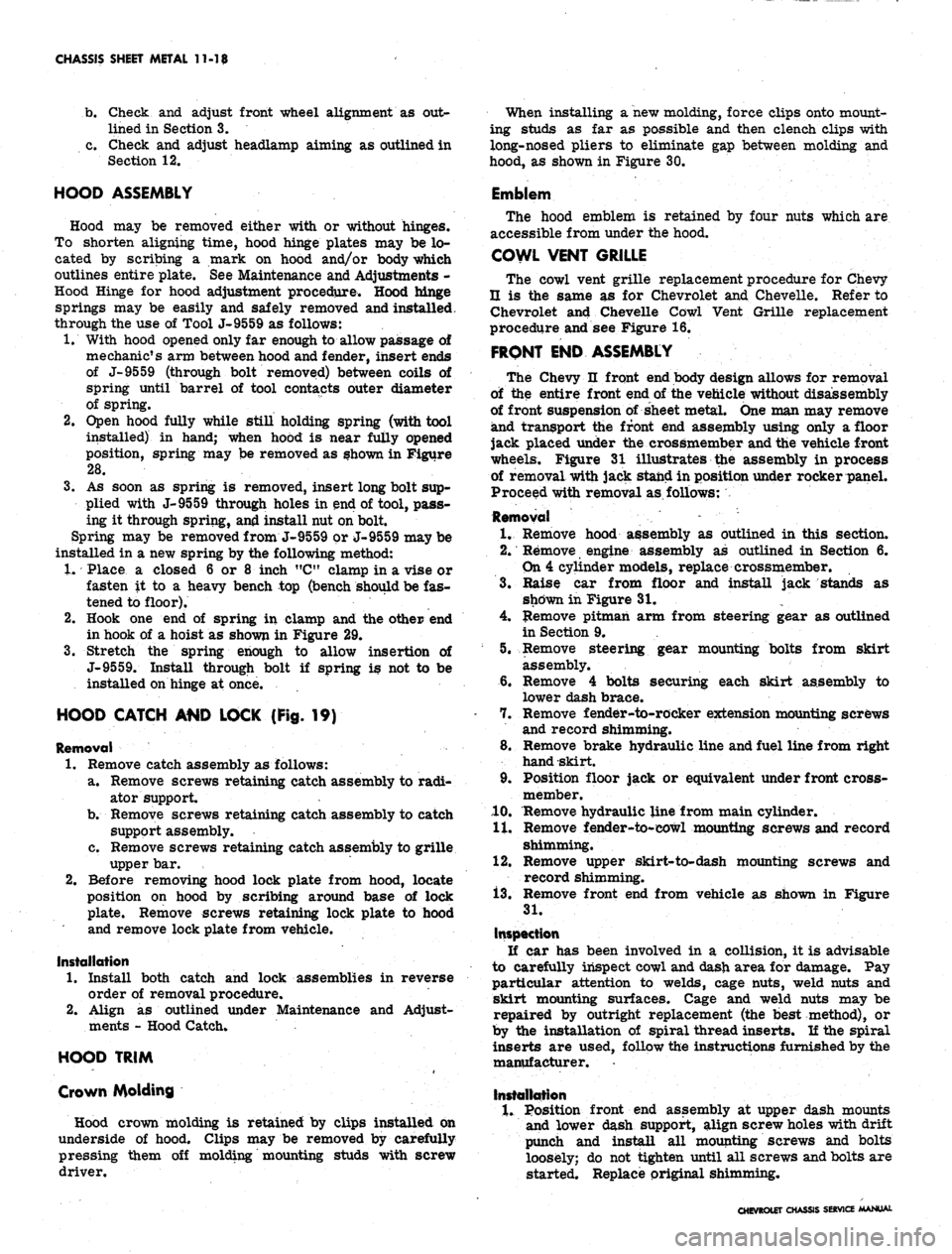
CHASSIS SHEET METAL 11-18
b.
Check and adjust front wheel alignment as out-
lined in Section 3.
c. Check and adjust headlamp aiming as outlined in
Section 12.
HOOD ASSEMBLY
Hood may be removed either with or without hinges.
To shorten aligning time, hood hinge plates may be lo-
cated by scribing a mark on hood and/or body which
outlines entire plate. See Maintenance and Adjustments -
Hood Hinge for hood adjustment procedure. Hood hinge
springs may be easily and safely removed and installed.
through the use of Tool J-9559 as follows:
1.
With hood opened only far enough to allow passage of
mechanic's arm between hood and fender, insert ends
of J-9559 (through bolt removed) between coils of
spring until barrel of tool contacts outer diameter
of spring.
2.
Open hood fully while still holding spring (with tool
installed) in hand; when hood is near fully opened
position, spring may be removed as shown in Figure
28.
3.
As soon as spring is removed, insert long bolt sup-
plied with J-9559 through holes in end of tool, pass-
ing it through spring, and install nut on bolt.
Spring may be removed from J-9559 or J-9559 may be
installed in a new spring by the following method:
1.
Place a closed 6 or 8 inch "C" clamp in a vise or
fasten it to a heavy bench top (bench should be fas-
tened to floor).
2.
Hook one end of spring in clamp and the other end
in hook of a hoist as shown in Figure 29.
3.
Stretch the spring enough to allow insertion of
J-9559. Install through bolt if spring is not to be
installed on hinge at once.
HOOD CATCH AMD LOCK (Fig. 19)
Removal
1.
Remove catch assembly as follows:
a. Remove screws retaining catch assembly to radi-
ator support.
b.
Remove screws retaining catch assembly to catch
support assembly.
c* Remove screws retaining catch assembly to grille
upper bar.
2.
Before removing hood lock plate from hood, locate
position on hood by scribing around base of lock
plate. Remove screws retaining lock plate to hood
and remove lock plate from vehicle.
Installation
1.
Install both catch and lock assemblies in reverse
order of removal procedure.
2.
Align as outlined under Maintenance and Adjust-
ments - Hood Catch.
HOOD TRIM
Crown Molding
Hood crown molding is retained by clips installed on
underside of hood. Clips may be removed by carefully
pressing them off molding mounting studs with screw
driver.
When installing a new molding, force clips onto mount-
ing studs as far as possible and then clench clips with
long-nosed pliers to eliminate gap between molding and
hood, as shown in Figure 30.
Emblem
The hood emblem is retained by four nuts which are
accessible from under the hood.
COWL VENT GRILLE
The cowl vent grille replacement procedure for Chevy
U is the same as for Chevrolet and Chevelle. Refer to
Chevrolet and Chevelle Cowl Vent Grille replacement
procedure and see Figure 16.
FRONT END ASSEMBLY
The Chevy n front end body design allows for removal
of the entire front end of the vehicle without disassembly
of front suspension of sheet metal. One man may remove
and transport the front end assembly using only a floor
jack placed under the crossmember and the vehicle front
wheels. Figure 31 illustrates the assembly in process
of removal with jack stand in position under rocker panel.
Proceed with removal
as.
follows:
Removal
1.
Remove hood assembly as outlined in this section.
2.
Remove engine assembly as outlined in Section 6.
On 4 cylinder models, replace crossmember.
3.
Raise car from floor and install jack stands as
shown in Figure 31.
4.
Remove pitman arm from steering gear as outlined
in Section 9.
5.
Remove steering gear mounting bolts from skirt
assembly.
6. Remove 4 bolts securing each skirt assembly to
lower dash brace.
7.
Remove fender-to-rocker extension mounting screws
and record shimming.
8. Remove brake hydraulic line and fuel line from right
hand skirt.
9. Position floor jack or equivalent under front cross-
member.
10.
Remove hydraulic line from main cylinder.
11.
Remove fender-to-cowl mounting screws and record
shimming.
12.
Remove upper skirt-to-dash mounting screws and
record shimming.
13.
Remove front end from vehicle as shown in Figure
31.
Inspection
If car has been involved in a collision, it is advisable
to carefully inspect cowl and dash area for damage. Pay
particular attention to welds, cage nuts, weld nuts and
skirt mounting surfaces. Cage and weld nuts may be
repaired by outright replacement (the best method), or
by the installation of spiral thread inserts. If the spiral
inserts are used, follow the instructions furnished by the
manufacturer. -
Installation
%, position front end assembly at upper dash mounts
and lower dash support, align screw holes with drift
punch and install all mounting screws and bolts
loosely; do not tighten until all screws and bolts are
started. Replace original shimming.
CHEVROLET CHASSIS SERVICE MANUAL
Page 509 of 659
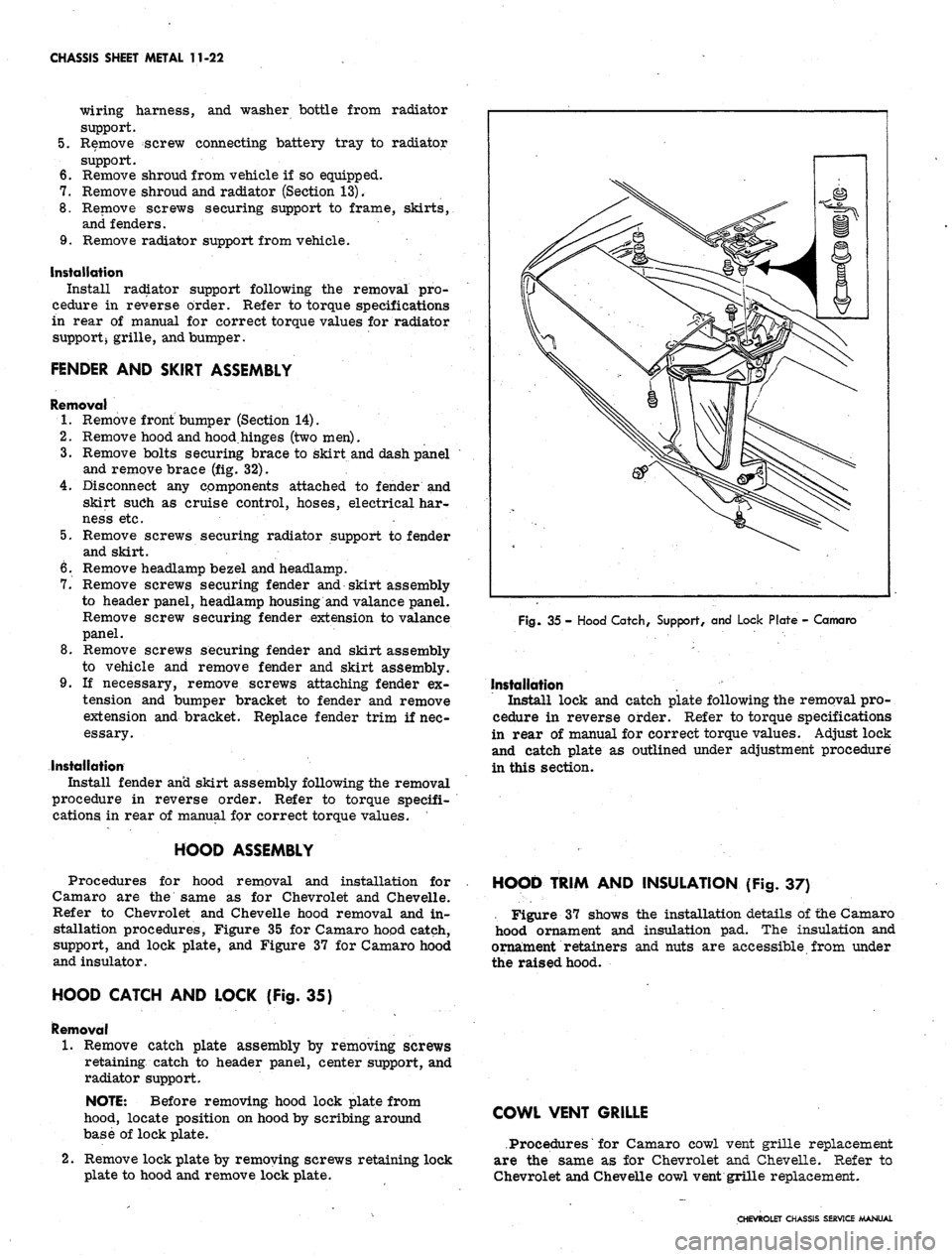
CHASSIS SHEET METAL 11-22
wiring harness, and washer bottle from radiator
support.
5.
Remove screw connecting battery tray to radiator
support.
6. Remove shroud from vehicle if so equipped.
7.
Remove shroud and radiator (Section 13).
8. Remove screws securing support to frame, skirts,
and fenders.
9. Remove radiator support from vehicle.
Installation
Install radiator support following the removal pro-
cedure in reverse order. Refer to torque specifications
in rear of manual for correct torque values for radiator
supportj grille, and bumper.
FENDER AND SKIRT ASSEMBLY
Removal
1.
Remove front bumper (Section 14).
2.
Remove hood and hood.hinges (two men).
3.
Remove bolts securing brace to skirt and dash panel
and remove brace (fig. 32).
4.
Disconnect any components attached to fender and
skirt such as cruise control, hoses, electrical har-
ness etc.
5.
Remove screws securing radiator support to fender
and skirt.
6. Remove headlamp bezel and headlamp.
7.
Remove screws securing fender and skirt assembly
to header panel, headlamp housing and valance panel.
Remove screw securing fender extension to valance
panel.
8. Remove screws securing fender and skirt assembly
to vehicle and remove fender and skirt assembly.
9. If necessary, remove screws attaching fender ex-
tension and bumper bracket to fender and remove
extension and bracket. Replace fender trim if nec-
essary.
Installation
Install fender anci skirt assembly following the removal
procedure in reverse order. Refer to torque specifi-
cations in rear of manual for correct torque values.
HOOD ASSEMBLY
Procedures for hood removal and installation for
Camaro are the same as for Chevrolet and Chevelle.
Refer to Chevrolet and Chevelle hood removal and in-
stallation procedures, Figure 35 for Camaro hood catch,
support, and lock plate, and Figure 37 for Camaro hood
and insulator.
HOOD CATCH AND LOCK (Fig. 35)
Removal
1.
Remove catch plate assembly by removing screws
retaining catch to header panel, center support, and
radiator support.
NOTE: Before removing hood lock plate from
hood, locate position on hood by scribing around
base of lock plate.
2.
Remove lock plate by removing screws retaining lock
plate to hood and remove lock plate.
Fig.
35 - Hood Catch, Support, and Lock Plate - Camaro
Installation
Install lock and catch plate following the removal pro-
cedure in reverse order. Refer to torque specifications
in rear of manual for correct torque values. Adjust lock
and catch plate as outlined under adjustment procedure
in this section.
HOOD TRIM AND INSULATION (Fig. 37}
. Figure 37 shows the installation details of the Camaro
hood ornament and insulation pad. The insulation and
ornament retainers and nuts are accessible from under
the raised hood.
COWL VENT GRILLE
.Procedures'for Camaro cowl vent grille replacement
are the same as for Chevrolet and Chevelle. Refer to
Chevrolet and Chevelle cowl vent grille replacement.
CHEVROLET CHASSIS SERVICE MANUAL
Page 513 of 659
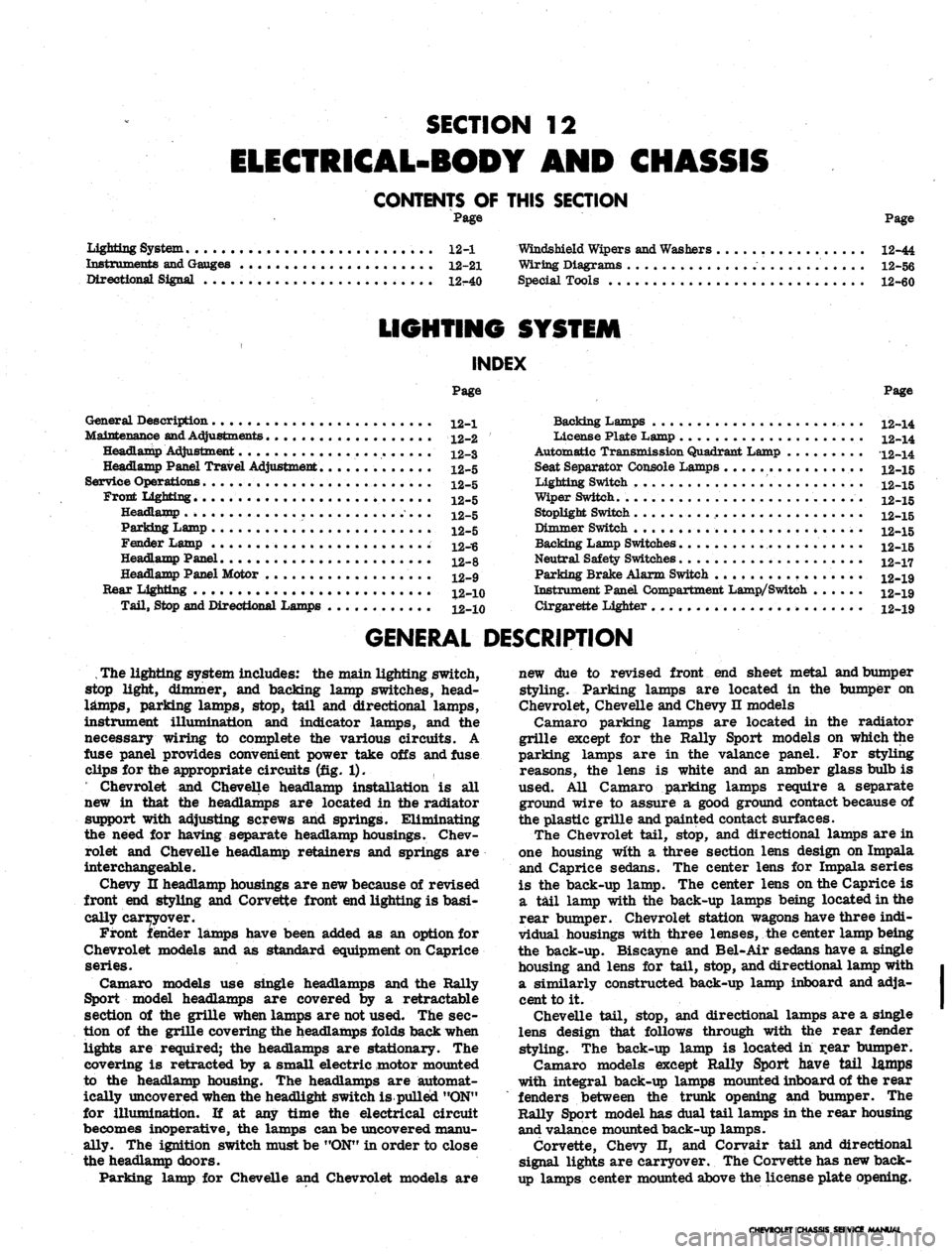
SECTION 12
ELECTRICAL-BODY AND CHASSIS
CONTENTS
OF
THIS
SECTION
Page
Page
System 12-1
Instruments and Gauges 12-21
Directional Signal 12r40
Windshield Wipers and Washers 12-44
Wiring Diagrams 12-56
Special Tools 12-60
LIGHTING SYSTEM
INDEX
Page
General Description
!2-i
Maintenance and Adjustments
•.................. 12-2
Headlamp Adjustment......................
12-3
Headlamp Panel Travel Adjustment.
12-5
Service Operations.
. . .. 12-5
Front Lighting
12-5
Headlamp
. 12_5
Parking Lamp
12-5
Fender Lamp
. 12_^
Headlamp Panel
12-8
Headlamp Panel Motor
^2-9
Rear Lighting
l2-10
Tail, Stop and Directional Lamps
12-10
Page
Backing Lamps
12-14
License Plate Lamp
12-14
Automatic Transmission Quadrant Lamp
12-14
Seat Separator Console Lamps
. 12-15
Lighting Switch
. . 12-15
Wiper Switch.
12-15
Stoplight Switch
12-15
Dimmer Switch
12-15
Backing Lamp Switches
12-15
Neutral Safety Switches
12-17
Parking Brake Alarm Switch
................. 12-19
Instrument Panel Compartment Lamp/Switch
12-19
Cirgarette Lighter
12-19
GENERAL DESCRIPTION
.
The lighting system includes: the main lighting switch,
stop light, dimmer, and backing lamp switches, head-
lamps, parking lamps, stop, tail and directional lamps,
instrument illumination and indicator lamps, and the
necessary wiring to complete the various circuits. A
fuse panel provides convenient power take offs and fuse
clips for the appropriate circuits (fig. 1).
Chevrolet and Chevelle headlamp installation is all
new in that the headlamps are located in the radiator
support with adjusting screws and springs. Eliminating
the need for having separate headlamp housings. Chev-
rolet and Chevelle headlamp retainers and springs are
interchangeable.
Chevy n headlamp housings are new because of revised
front end styling and Corvette front end lighting is basi-
cally carryover.
Front fender lamps have been added as an option for
Chevrolet models and as standard equipment on Caprice
series.
Camaro models use single headlamps and the Rally
Sport model headlamps are covered by a retractable
section of the grille when lamps are not used. The sec-
tion of the grille covering the headlamps folds back when
lights are required; the headlamps are stationary. The
covering is retracted by a small electric motor mounted
to the headlamp housing. The headlamps are automat-
ically uncovered when the headlight switch is pulled "ON"
for illumination. If at any time the electrical circuit
becomes inoperative, the lamps can be uncovered manu-
ally. The ignition switch must be
"ON"
in order to close
the headlamp doors.
Parking lamp for Chevelle and Chevrolet models are
new due to revised front end sheet metal and bumper
styling. Parking lamps are located in the bumper on
Chevrolet, Chevelle and Chevy n models
Camaro parking lamps are located in the radiator
grille except for the Rally Sport models on which the
parking lamps are in the valance panel. For styling
reasons, the lens is white and an amber glass bulb is
used. All Camaro parking lamps require a separate
ground wire to assure a good ground contact because of
the plastic grille and painted contact surfaces.
The Chevrolet tail, stop, and directional lamps are in
one housing with a three section lens design on Impala
and Caprice sedans. The center lens for Impala series
is the back-up lamp. The center lens on the Caprice is
a tail lamp with the back-up lamps being located in the
rear bumper. Chevrolet station wagons have three indi-
vidual housings with three lenses, the center lamp being
the back-up. Biscayne and Bel-Air sedans have a single
housing and lens for tail, stop, and directional lamp with
a similarly constructed back-up lamp inboard and adja-
cent to it.
Chevelle tail, stop, and directional lamps are a single
lens design that follows through with the rear fender
styling. The back-up lamp is located in r.ear bumper.
Camaro models except Rally Sport have tail lamps
with integral back-up lamps mounted inboard of the rear
fenders between the trunk opening and bumper. The
Rally Sport model has dual tail lamps in the rear housing
and valance mounted back-up lamps.
Corvette, Chevy n, and Corvair tail and directional
signal lights are carryover. The Corvette has new back-
up lamps center mounted above the license plate opening.
CHEVROLET CHASSIS SERVICE
Page 515 of 659
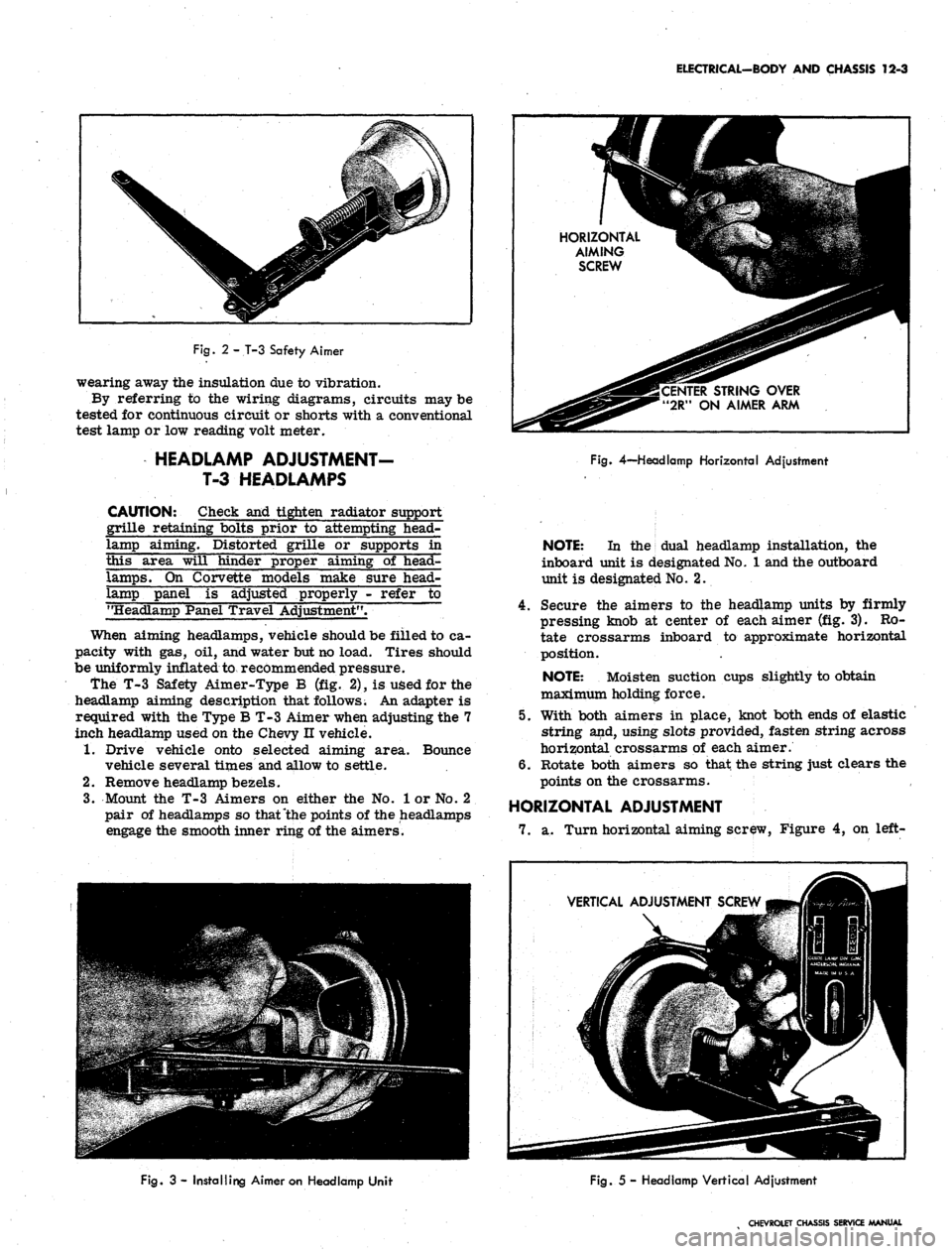
ELECTRICAL-BODY AND CHASSIS 12-3
Fig.
2 - T-3 Safety Aimer
wearing away the insulation due to vibration.
By referring to the wiring diagrams, circuits may be
tested for continuous circuit or shorts with a conventional
test lamp or low reading volt meter.
HEADLAMP ADJUSTMENT-
T-3 HEADLAMPS
CAUTION: Check and tighten radiator support
grille retaining bolts prior to attempting head-
lamp aiming. Distorted grille or supports in
this area will hinder proper aiming of head-
lamps. On Corvette models make sure head-
lamp panel is adjusted properly - refer to
"Headlamp Panel Travel Adjustment".
When aiming headlamps, vehicle should be filled to ca-
pacity with gas, oil, and water but no load. Tires should
be uniformly inflated to recommended pressure.
the T-3 Safety Aimer-Type B (fig. 2), is used for the
headlamp aiming description that follows. An adapter is
required with the Type B T-3 Aimer when adjusting the 7
inch headlamp used on the Chevy n vehicle.
1.
Drive vehicle onto selected aiming area. Bounce
vehicle several times and allow to settle.
2.
Remove headlamp bezels.
3.
Mount the T-3 Aimers on either the No. 1 or No. 2
pair of headlamps so that "the points of the headlamps
engage the smooth inner ring of the aimers.
HORIZONTAL
AIMING
SCREW
STRING OVER
"2R" ON AIMER ARM
Fig.
4—-Headlamp Horizontal Adjustment
NOTE:
In the dual headlamp installation, the
inboard unit is designated No. 1 and the outboard
unit is designated No. 2.
4.
Secure the aimers to the headlamp units by firmly
pressing knob at center of each aimer (fig. 3). Ro-
tate crossarms inboard to approximate horizontal
position.
NOTE:
Moisten suction cups slightly to obtain
maximum holding force.
5. With both aimers in place, knot both ends of elastic
string and, using slots provided, fasten string across
horizontal crossarms of each aimer.
6. Rotate both aimers so that the string just clears the
points on the crossarms.
HORIZONTAL ADJUSTMENT
7. a. Turn horizontal aiming screw, Figure 4, on left-
VERTICAL ADJUSTMENT SCREW
Fig.
3 - Installing Aimer on Headlamp Unit
Fig.
5 - Headlamp Vertical Adjustment
CHEVROLET CHASSIS SERVICE MANUAL
Page 516 of 659
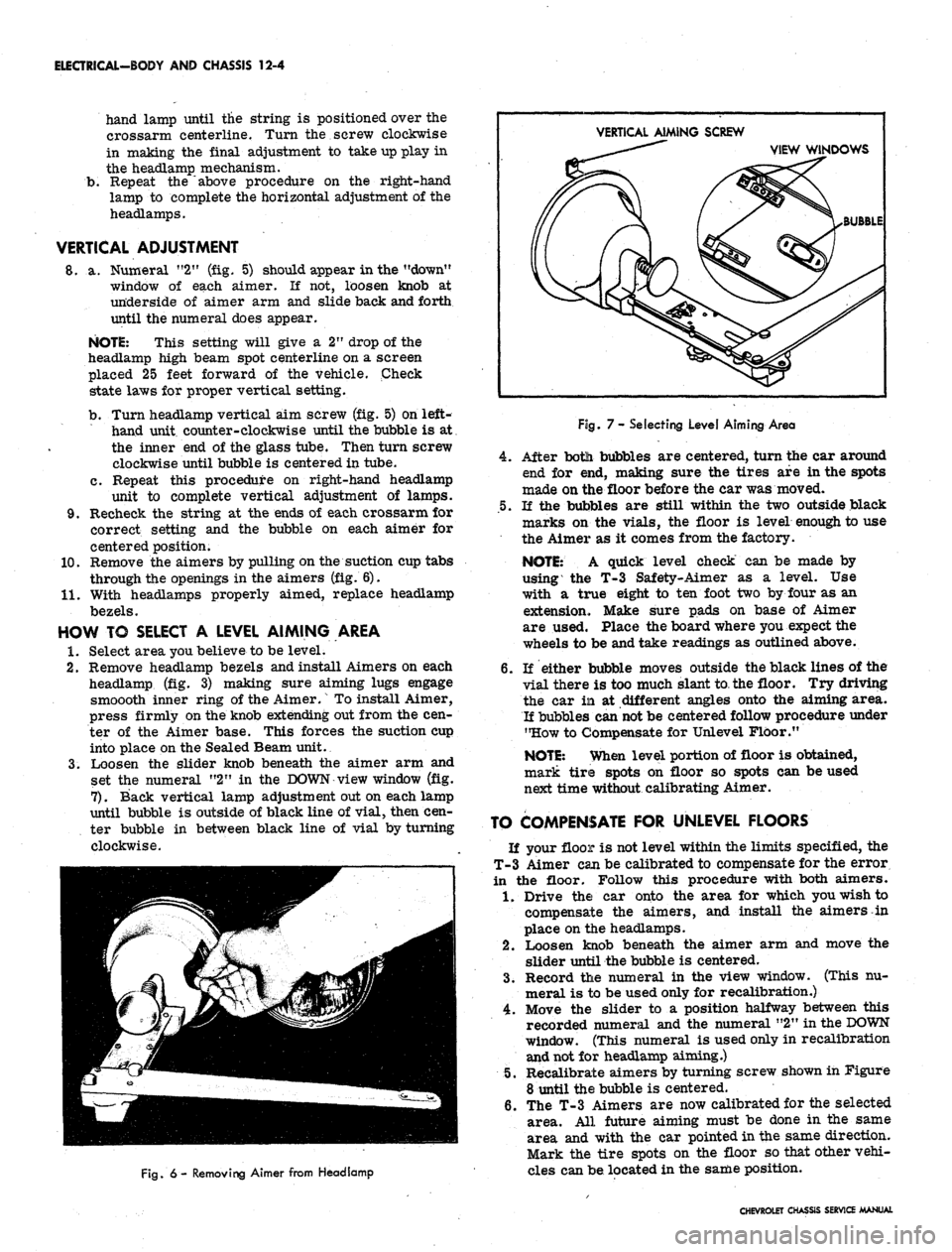
ELECTRICAL-BODY AND CHASSIS 12-4
b.
hand lamp until the string is positioned over the
crossarm centerline. Turn the screw clockwise
in making the final adjustment to take up play in
the headlamp mechanism.
Repeat the above procedure on the right-hand
lamp to complete the horizontal adjustment of the
headlamps.
VERTICAL ADJUSTMENT
8. a. Numeral "2" (fig. 5) should appear in the "down"
window of each aimer. If not, loosen knob at
underside of aimer arm and slide back and forth
until the numeral does appear.
NOTE:
This setting will give a 2" drop of the
headlamp high beam spot centerline on a screen
placed 25 feet forward of the vehicle. Check
state laws for proper vertical setting.
b.
Turn headlamp vertical aim screw (fig. 5) on left-
hand unit counter-clockwise until the bubble is at
the inner end of the glass tube. Then turn screw
clockwise until bubble is centered in tube.
c. Repeat this procedure on right-hand headlamp
unit to complete vertical adjustment of lamps.
9. Recheck the string at the ends of each crossarm for
correct setting and the bubble on each aimer for
centered position.
10.
Remove the aimers by pulling on the suction cup tabs
through the openings in the aimers (fig. 6).
11.
With headlamps properly aimed, replace headlamp
bezels.
HOW TO SELECT A LEVEL AIMING AREA
1.
Select area you believe to be level.
2.
Remove headlamp bezels and install Aimers on each
headlamp (fig. 3) making sure aiming lugs engage
smoooth inner ring of the Aimer.
"
To install Aimer,
press firmly on the knob extending out from the cen-
ter of the Aimer base. This forces the suction cup
into place on the Sealed Beam unit.:
3.
Loosen the slider knob beneath the aimer arm and
set the numeral "2" in the DOWN view window (fig.
7).
Back vertical lamp adjustment out on each lamp
until bubble is outside of black line of vial, then cen-
ter bubble in between black line of vial by turning
clockwise.
VERTICAL AIMING SCREW
VIEW WINDOWS
BUBBLE
Fig.
6 - Removing Aimer from Headlamp
Fog.
7- Selecting Level Aiming Area
4.
After botli bubbles are centered, turn the car around
end for end, making sure the tires are in the spots
made on the floor before the car was moved.
.5.
If the bubbles are still within the two outside black
marks on the vials, the floor is level enough to use
the Aimer as it comes from the factory.
NOTE:
A quick level check can be made by
using the T-3 Safety-Aimer as a level. Use
with a true eight to ten foot two by four as an
extension. Make sure pads on base of Aimer
are used. Place the board where you expect the
wheels to be and take readings as outlined above.
6. If either bubble moves outside the black lines of the
vial there is too much slant to the floor. Try driving
the car in at different angles onto the aiming area.
If bubbles can
not
be centered follow procedure under
"How to Compensate for Unlevel Floor."
NOTE:
When level portion of floor is obtained,
mark tire spots on floor so spots can be used
next time without calibrating Aimer.
TO COMPENSATE FOR UNLEVEL FLOORS
If your floor is not level within the limits specified, the
T-3 Aimer can be calibrated to compensate for the error
in the floor. Follow this procedure with both aimers.
1.
Drive the car onto the area for which you wish to
compensate the aimers, and install the aimers in
place on the headlamps.
2.
Loosen knob beneath the aimer arm and move the
slider until the bubble is centered.
3.
Record the numeral in the view window. (This nu-
meral is to be used only for recalibration.)
4.
Move the slider to a position halfway between this
recorded numeral and the numeral "2" in the
DOWN
window. (This numeral is used only in recalibration
and not for headlamp aiming.)
5.
Recalibrate aimers by turning screw shown in Figure
8 until the bubble is centered.
6. The T-3 Aimers are now calibrated for the selected
area. All future aiming must be done in the same
area and with the car pointed in the same direction.
Mark the tire spots on the floor so that other vehi-
cles can be located in the same position.
CHEVROLET CHASSIS SERVICE MANUAL
Page 517 of 659
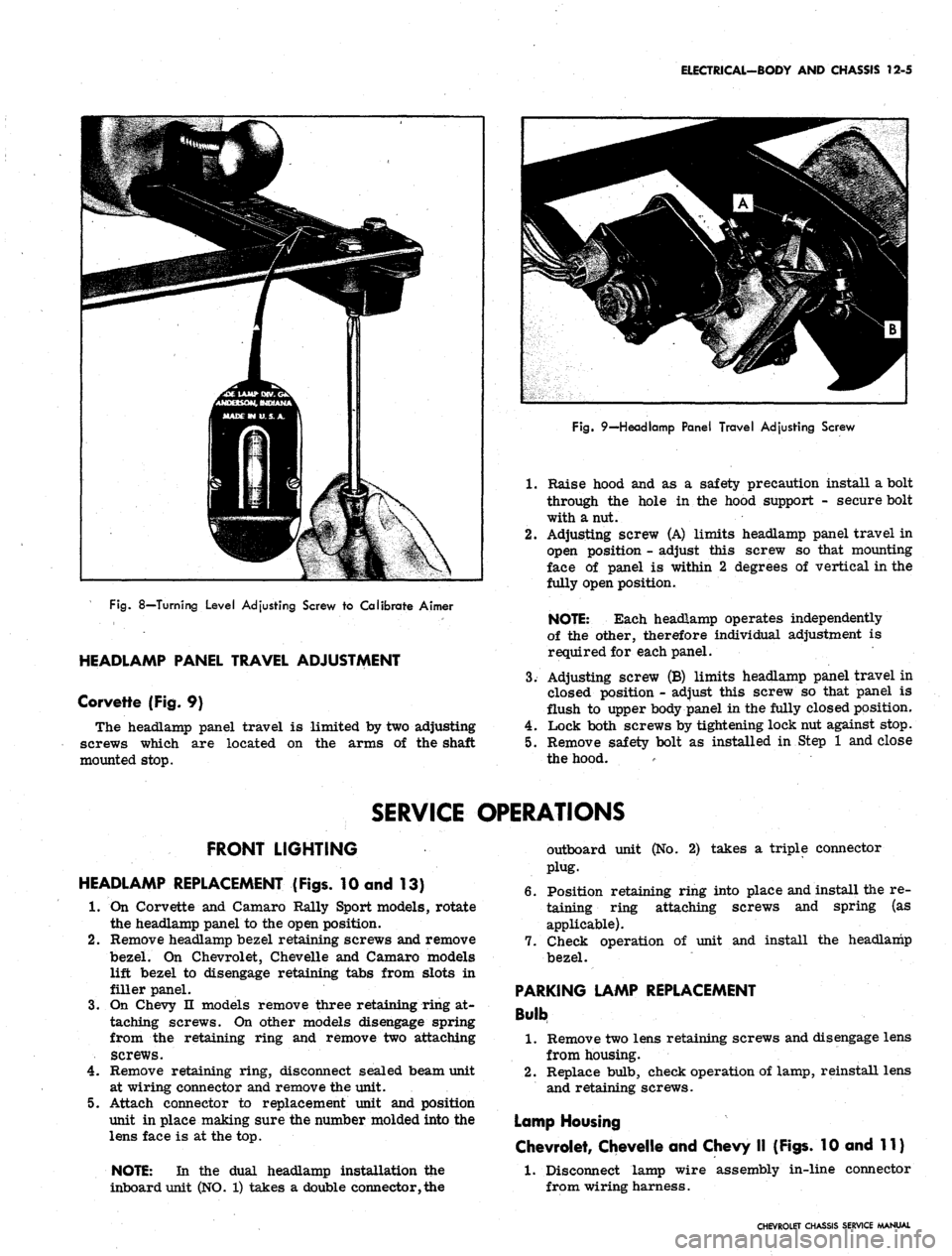
ELECTRICAL-BODY AND CHASSIS 12-5
Fig.
8—Turning Level Adjusting Screw to Calibrate Aimer
HEADLAMP PANEL TRAVEL ADJUSTMENT
Corvette (Fig. 9)
The headlamp panel travel is limited by two adjusting
screws which are located on the arms of the shaft
mounted stop.
Fig.
9—Headlamp Panel Travel Adjusting Screw
1.
Raise hood and as a safety precaution install a bolt
through the hole in the hood support - secure bolt
with a nut.
2.
Adjusting screw (A) limits headlamp panel travel in
open position - adjust this screw so that mounting
face of panel is within 2 degrees of vertical in the
fully open position.
NOTE: Each headlamp operates independently
of the other, therefore individual adjustment is
required for each panel.
3.
Adjusting screw (B) limits headlamp panel travel in
closed position - adjust this screw so that panel is
flush to upper body panel in the fully closed position.
4.
Lock both screws by tightening lock nut against stop.
5.
Remove safety bolt as installed in Step 1 and close
the hood.
SERVICE OPERATIONS
FRONT LIGHTING
HEADLAMP REPLACEMENT (Figs. 10 and 13)
1.
On Corvette and Camaro Rally Sport models, rotate
the headlamp panel to the open position.
2.
Remove headlamp bezel retaining screws and remove
bezel. On Chevrolet, Chevelle and Camaro models
lift bezel to disengage retaining tabs from slots in
filler panel.
3.
On Chevy n models remove three retaining ring at-
taching screws. On other models disengage spring
from the retaining ring and remove two attaching
screws.
4.
Remove retaining ring, disconnect sealed beam unit
at wiring connector and remove the unit.
5.
Attach connector to replacement unit and position
unit in place making sure the number molded into the
lens face is at the top.
NOTE: In the dual headlamp installation the
inboard unit (NO. 1) takes a double connector, the
outboard unit (No. 2) takes a triple connector
plug.
6. Position retaining ring into place and install the re-
taining ring attaching screws and spring (as
applicable).
7.
Check operation of unit and install the headlamp
bezel.
PARKING LAMP REPLACEMENT
Bulb
1.
Remove two lens retaining screws and disengage lens
from housing.
2.
Replace bulb, check operation of lamp, reinstall lens
and retaining screws.
Lamp Housing
Chevrolet, Chevelle and Chevy II (Figs. 10 and 11)
1.
Disconnect lamp wire assembly in-line connector
from wiring harness.
CHEVROLET CHASSIS SERVICE MANUAL